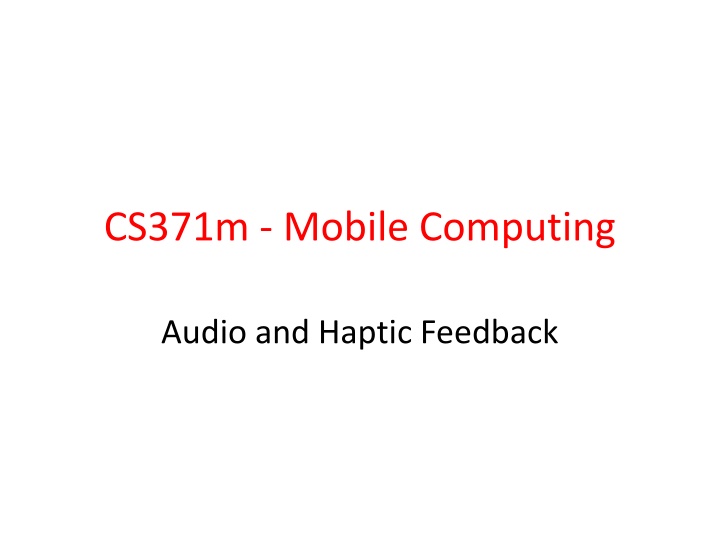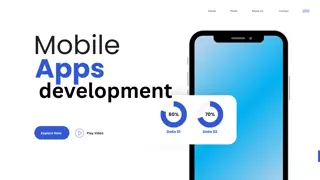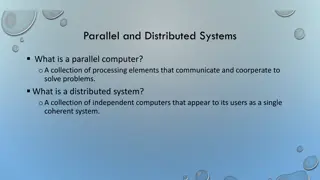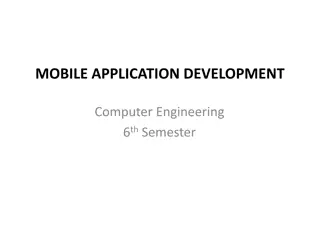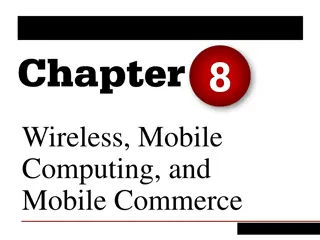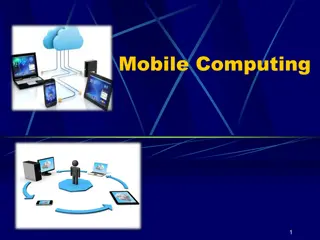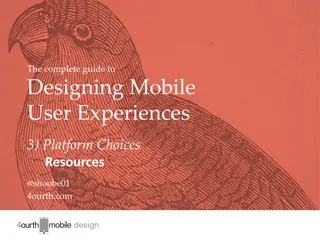CS371m - Mobile Computing
This content delves into the realm of audio and haptic feedback in mobile computing, exploring the use of audio resources, MediaPlayer for playback control, Android MediaPlayer class for common audio formats, and more. It covers aspects such as managing multiple audio streams on devices, utilizing various audio sources, handling MediaPlayer state transitions, and implementing audio feedback in mobile apps. Dive into the world of audio interaction in mobile applications through this informative content.
Download Presentation

Please find below an Image/Link to download the presentation.
The content on the website is provided AS IS for your information and personal use only. It may not be sold, licensed, or shared on other websites without obtaining consent from the author.If you encounter any issues during the download, it is possible that the publisher has removed the file from their server.
You are allowed to download the files provided on this website for personal or commercial use, subject to the condition that they are used lawfully. All files are the property of their respective owners.
The content on the website is provided AS IS for your information and personal use only. It may not be sold, licensed, or shared on other websites without obtaining consent from the author.
E N D
Presentation Transcript
CS371m - Mobile Computing Audio and Haptic Feedback
Clicker On the whole, do you like apps to provide audio and / or haptic feedback or not? A. No B. Yes 2
Audio on Device Devices have multiple audio streams: music, alarms, notifications, incoming call ringer, in call volume, system sounds, DTMF tones (dual tone multi frequency, the "traditional" phone sounds and tones) Most of the streams are restricted to system events, so we almost always use STREAM_MUSIC via a MediaPlayer or SoundPool 3
Android Audio Using the Android MediaPlayer class Common Audio Formats supported: MP3, MIDI (.mid and others), Vorbis (.ogg), WAVE (.wav) and others Sources of audio local resources (part of app) internal URIs (Content Provider for other audio available) External URLs (streaming) 5
Audio Resources res/raw directory assets/ directory reference as file://andorid_asset in a URI can share with other apps via URI Store media in application local directory, pull from network / web and store locally Store and use media on SD card Stream via the Internet 6
MediaPlayer Playback control of MediaPlayer managed as a state machine Idle Initialized Preparing Prepared Started Paused Playback Complete Stopped End Invalid state transitions result in errors 7
MediaPlayer State Diagram Single arrows are synchronous transitions Double arrows are asynchronous transitions 8
Simple Sound Demo App audio files local to app placed in res/raw CAUTION large sound files difficult to install on emulator: http://tinyurl.com/3pwljfj better success with dev phones / actual devices 9
Using MediaPlayer MediaPlayer.create() method used for raw resources MediaPlayer.create() method for URIs various MediaPlayer.setDataSource() methods if not a raw resource and not a URI 10
Playing Local Audio To play audio local to the app use the MediaPlayer.create convenience method when complete MediaPlayer in the prepared state start MediaPlayer approach: build listeners for each button to call the playSound method with appropriate song id when clicked 11
Simple Approach button ids ids for sound files 12
playSound method initial version useful for short sounds downsides: plays to completion multiple sounds play at same time (desirable in some cases) audio continues to play when app paused 13
Changing Behavior Add instance variable for MediaPlayer If playing stop and release before creating new Player 14
Cleaning Up Initial version did not end well Audio continued to play if back button pressed and even if home button pressed! Activity Life Cycle in onPause for app we should stop MediaPlayer and release 15
stopPlayer method Connect app stop button to stopPlayer could use XML onClick and add View parameter or set up listener ourselves in buildListeners method 16
onPause onPause() should call the stopPlayer method what happens if activity resumed? 17
Saving State Resume music where we left off if paused or activity destroyed due to orientation change 18
Saving MediaPlayer State Not a lot of data so used the SharedPreferences 19
Restarting Audio In onResume check if audio was interrupted recreate player with same id and move to correct position Can write data to shared preferences or bundle (onSaveInstanceState) and pull out in onResume 20
Playing Audio from Phone If audio is on device / system, but not local to app use a URI Obtain URIs of Music via a Content Resolver Example of simply listing URIs to the logcat 22
Retrieving Music URIs Using a Content Resolver 23
MediaPlayer and System Audio After URI retrieved can play audio with MediaPlayer this approach requires calling MediaPlayer prepare yourself Or could use MediaPlayer create method that takes a URI 24
Playing Audio Via Local URI id obtained via approach from showContent method 25
Other Audio Other audio for ringtones, notifications, and alarms can be accessed via a RingtoneManager Obtain URIs and play with media player from DDMS: 26
Playing Other Audio Once the URI is obtained, playing other audio is same as playing song 28
Playing Audio from Remote URL Straightforward given the URL 29
Completion of Audio If action required when audio done playing implement the MediaPlayer.onCompletionListener interface could make activity the listener 30
Looping to loop sound (play over and over) simply set the isLooping method of the MediaPlayer to true 31
SOUND POOL 32
SoundPool Another Android class Used in tutorials 33
Using SoundPool Great for applications with a number of short sound samples maxStreams parameter sets maximum number of sounds that can be played at once via this SoundPool If max is exceeded stream with lowest priority stopped and then by age (oldest) with lowest priority 34
Using SoundPool Looping of sounds: 0 no looping -1 loop forever >0, play that many times frequency (speed) can be changed range from 0.5 to 2.0 0.5 twice as long to play 2.0 half as long to play 36
SoundPool.Builder Added in API level 21, Android 5.0 Lollipop static methods to set audio attributes set max number of streams build and return a SoundPool object given the current audio attributes and number of streams Audio Attributes include why, what and how for sound USAGE_GAME, CONTENT_TYPE_SONIFICATION, various flags 37
Other Sources of Sound AudioTrack http://developer.android.com/reference/android/media/AudioTrack.html low level API for handling audio streams in formats MediaPlayer cannot handle ToneGenerator http://developer.android.com/reference/android/media/ToneGenerator.html Traditional phone tones Dual-Tone Multi-Frequency (DTMF) Just to make sounds, not send tones over phone network 38
Haptic Feedback haptic: "of or relating to the sense of touch" Easy to add this kind of feedback to an app can enable haptic feedback for any view 41
Haptic Feedback on a View Methods from View class 42
More Complex Feedback Also possible to create more complex haptic feedback for apps: Request permission Get the Vibrator object from the system call vibrate method 44
Haptic Feedback Request Permission Get Vibrator 45
Haptic Feedback Create feedback 46
Recording Audio - MediaRecorder 1. create MediaRecorder object 2. set audio source 3. set audio format 4. set file format for audio 5. set file name to record to 6. prepare MediaRecorder for recording 7. start recording 8. stop and release MediaRecorder 49
Record Audio Simple View with buttons to start and stop recording alternatively could change text on record audio button single button or toggle switch 50
